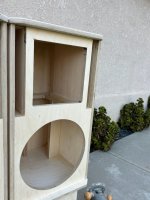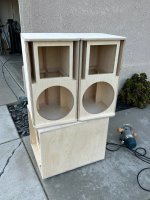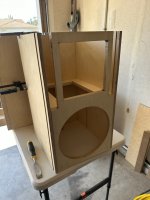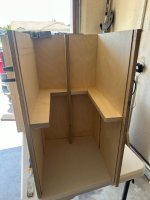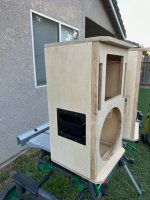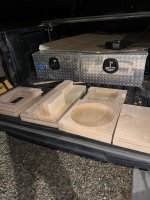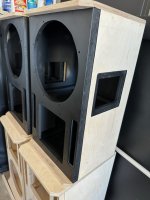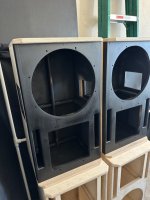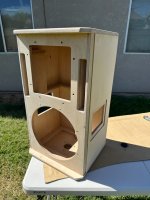Well I want very clean mid range from 750Hz up and clean, undistorted at 20K but I think we all know that isn't possible from a single compression driver.
You will not get clean 20k, the big diaphragms of 4" will always have resonances and decay ridges, most don't reach the 20k at all. The datasheet of the ND950 claims 20k but the fr says otherwise.
The ND1460 has a 3" VC, it does 20k but not resonance free either.
I use generous amounts of PL Premium construction adhesive and hold the panels with a brad gun. PL expands slightly and you can work it into a fillet, it's like peanut butter and doesn't run. A gap that would make a wood glue joint worthless is perfect for the PL and you don't have to horse the thing together while the open time is ticking. Also every screw head I've ever filled has popped from moisture/temp cycling. I'm weary of fine woodworking and this gets me a bombproof cabinet with minimal effort.
One is never going to get the smooth curve above 10k that is exhibited by a 3/4” soft dome mounted on a large baffle in an anechoic chamber out of a compression driver firing into a horn, and then into a venue. All the wavefront needs to do is hit any sort of edge, anywhere, to produce ripples like that. A single big spike you want to avoid, because that is indicative of energy storage. That you will hear. And a lot of CDs have it.You will not get clean 20k, the big diaphragms of 4" will always have resonances and decay ridges, most don't reach the 20k at all. The datasheet of the ND950 claims 20k but the fr says otherwise.
View attachment 1336549
The ND1460 has a 3" VC, it does 20k but not resonance free either.
Hey guys so I am dealing with some real back-order issues on the ND1460 driver. One seller is suggesting I should try the Eminence N314T or the N314X. Do any of you have hands on experience with these drivers? They look good on paper.
I've tested and listened to the Eminence N314T, it was not as smooth and had less <1kHz output compared to other 3" diaphragm drivers, the B&C DE82, EV DH1A and Celestion CDX14-3050.
The newer B&C DE 880 design has very clean (short decay time) and smoother HF response compared to the drivers listed above.
The N314X has similar response to the N314T, with less ringing than the B&C DE 880.
18 Sound TPM ("True Piston Motion") Nitride coated Titanium diaphragms have very short decay times.
Most users prefer a bit more ringing, as it makes it seem like the HF has more "presence".
Because of the higher cost and reduced market for drivers with less ringing, they tend to be harder to source.
Art
The newer B&C DE 880 design has very clean (short decay time) and smoother HF response compared to the drivers listed above.
The N314X has similar response to the N314T, with less ringing than the B&C DE 880.
18 Sound TPM ("True Piston Motion") Nitride coated Titanium diaphragms have very short decay times.
Most users prefer a bit more ringing, as it makes it seem like the HF has more "presence".
Because of the higher cost and reduced market for drivers with less ringing, they tend to be harder to source.
Art
Hi Art,
That is super helpful feedback. I do see the 18sound NDS1480N looks very nice. Last evening I managed to find a couple RCF ND950's in stock so I grabbed the last 2 they had. Definitely was not my first choice. Depending how they sound, I may replace them when B&C, 18sound's inventory problems are solved.
That is super helpful feedback. I do see the 18sound NDS1480N looks very nice. Last evening I managed to find a couple RCF ND950's in stock so I grabbed the last 2 they had. Definitely was not my first choice. Depending how they sound, I may replace them when B&C, 18sound's inventory problems are solved.
Nice to see this coming to life! I’m also in process of designing a pretty similar speaker, and I also want to use the b&c recommended enclosure parameters. My chosen mid driver is the 12ndl76 and it’s gonna be combined with SB Audience cd65t on a RCF HF94 horn. I was wondering how you came up with the port dimensions? I also want to split the port into two ports left and right of the horn to save on space but didn’t find a common rule on how to divide ports without changing the tuning..
Hello,Nice to see this coming to life! I’m also in process of designing a pretty similar speaker, and I also want to use the b&c recommended enclosure parameters. My chosen mid driver is the 12ndl76 and it’s gonna be combined with SB Audience cd65t on a RCF HF94 horn. I was wondering how you came up with the port dimensions? I also want to split the port into two ports left and right of the horn to save on space but didn’t find a common rule on how to divide ports without changing the tuning..
First I am pretty slow to give any advice on this because I am not a professional by any means. Also, I am in the middle of building these enclosures right now and I have found inaccuracy's in the dimensions that I uploaded so please don't use any drawings I share unless you are willing to toss them out if they don't work. There are far better people on this forum to give you advice.
I will say that I used winISD to calculate vent dimensions. You can select the type of port and the number of ports and adjust frequency/enclosure volume to get the desired parameters you are after. The speaker database in the program is lacking at best but it is pretty simple to load parameters for whatever driver you want to use. Make sure you add the specs in the following order:
Sd, Re, Qes, Qms, VAS, Fs, Xmax. At the very least I can say to watch your cone excursion values and port velocity values.
Ultimately, I bounced my enclosure volume and port dimensions off of a few other professionals (vendors I was buying drivers from) to make sure I was at least in the ball park. Reps from two of the most well known vendors are super helpful. It is also possible that given your end goals, sticking to spec enclosure volume may not be the best solution so I'll let others chime in on that.
Is your application home stereo or pro audio?
Okay I see I see.. so you stuck to the manufacturers recommendations but simulated in winisd to make sure the split ports work out. I think I might stick completely with the recommendations from the drivers datasheet and make it one big slot port under the mid driver. I add 4/5cm to the cabinets height doing that but that shouldn’t be a big issue..
They’re gonna be used as PA Tops as well as at Home.
They’re gonna be used as PA Tops as well as at Home.
I'll post pictures of my enclosures here in a few days. But yea don't forget to check driver dimensions. Especially width. I realized last night when I was getting ready to do the mid range driver cut out, that I had changed models from when I initially did the drawing and never resized the outer diamiter so my internal width is like a 1/4" to narrow. I do have a fix for it that will be fine just have to go a different route for a grill. fortunately I didn't order that yet.
Cool, will be good to see how it went! I’m sketching up my own version as we speak, I want a symmetrically angled backside 🙂
But very inspiring thread anyways.. you did a good job of calculating the net volume of the cabinet! Wondering why the damping wool is included in those calculations, I thought it makes the space it is applied to acoustically larger?
But very inspiring thread anyways.. you did a good job of calculating the net volume of the cabinet! Wondering why the damping wool is included in those calculations, I thought it makes the space it is applied to acoustically larger?
Well I was planning to use a sheet product called sonic barrier rather than wool. My plan was to use the sonic barrier to fine tune the internal volume once the build is complete. You may be right in your assumption though. I guess I was thinking about the physical volume but perhaps that is not the right approach.
Okay so the prototype cabinets are done, minus the routing for handles and pole cup. See Attached. (waiting for horns to do COG) I do not plan to upload "as built" drawings because the end product was just to heavy and not necessarily a simple build if you don't have a proper router table, which I don't. I intend to follow through and use these as a learning experience for the final design which will use 15mm bb plywood. It was quite time consuming using mdf templates and a handle held router. I just feel there are better way to do this but they are still compact enough that I plan to use them for the next 6 months or so. Let's just say this has been a learning experience for sure. Lots of mistakes were made 😡
I have about 2 weeks until the horns come in. So I would like to use that time to focus on the crossover. I am having trouble finding affordable inductors for a 4th order crossover.
As for dsp amps: I currently have 2 Lab Gruppen IPD2400's and 1 QSC GXD8. Ideally I would like to run with strictly the Lab's for most events using one amp per side. One channel for the sub and one channel for the tops. This will allow me to run 1 NL4 cable to the sub and jump to the top from the sub keeping both the amp rack size and speaker cabling minimized. I can use the GXD8 in a separate case to run a second set of subs for larger events if needed.
In order to do this, I will obviously need a passive crossover for the tops. I don't need eq or enclosure HPF as that can be done in the amp. So I guess for the moment, I have a couple questions:
I find that I really like the sound of the RCF horn crossed between 750 and 800, granted the little exposure time I've had, has been somewhat limited and not in ideal situations. Additionally, I haven't compared that to a 1k or 1.2k crossover using the same drivers.
1. Do you guys have any thoughts on the ultimate crossover frequency for this particular combination should be? (RCF 950 1.4, RCF HF94, B&C 12NDL88)
2. Recommendations for places to buy inductors that will handle 800 watts rms? Or should I consider winding my own air core units.
Thanks in advance
-Ken
I have about 2 weeks until the horns come in. So I would like to use that time to focus on the crossover. I am having trouble finding affordable inductors for a 4th order crossover.
As for dsp amps: I currently have 2 Lab Gruppen IPD2400's and 1 QSC GXD8. Ideally I would like to run with strictly the Lab's for most events using one amp per side. One channel for the sub and one channel for the tops. This will allow me to run 1 NL4 cable to the sub and jump to the top from the sub keeping both the amp rack size and speaker cabling minimized. I can use the GXD8 in a separate case to run a second set of subs for larger events if needed.
In order to do this, I will obviously need a passive crossover for the tops. I don't need eq or enclosure HPF as that can be done in the amp. So I guess for the moment, I have a couple questions:
I find that I really like the sound of the RCF horn crossed between 750 and 800, granted the little exposure time I've had, has been somewhat limited and not in ideal situations. Additionally, I haven't compared that to a 1k or 1.2k crossover using the same drivers.
1. Do you guys have any thoughts on the ultimate crossover frequency for this particular combination should be? (RCF 950 1.4, RCF HF94, B&C 12NDL88)
2. Recommendations for places to buy inductors that will handle 800 watts rms? Or should I consider winding my own air core units.
Thanks in advance
-Ken
Attachments
For woofer inductors I would be winding my own IRON core units. Open iron cores made from stuffing only the E’s back into the bobbin of a 100-200ish VA power transformer. That gives laminations of about the right size. 16 or so gauge wire. You end up with fractional ohm DCR. I often use RECYCLED magnet wire from power transformer tear-downs as it can’t be used in a power transformer anymore, but no rule in the book about speaker inductors. Multiple polyurethane dips can be used to set everything if you are worried about minimizing distortion from magnetostriction. Buying inductors you just end up paying through the nose and a crossover can easily add $500 or more to a build. It is for this reason the passive XO is usually omitted from serious DIY PA builds, as you can buy an AMP for that. Air core for the tweeter if you can’t cheaply source ferrite bobbins which can do upper audio frequency well. Smaller wire can be used, as long as it can take a few amps. If you end up with 1.5 ohms of DCR so be it, be it - just tune it in with whatever value you end up with and don’t obsess over a low value since you’ll attenuate the HF anyway. Woofer caps can be snap-in electroltyics, wired as NPs. Modern ones are meant for mains power reservoirs in SMPS and can handle several amps of ripple current. Multiple back to back pairs that add up to the desired value are usually better, as the total ripple current rating will be higher. Metalized polypropylene in the tweeter circuit. I’ve been known to use MKP ceiling fan caps and similar.
Building crossovers is an art with a steep learning curve but IMO well worth the effort to learn and set up infrastructure to do if you are into any serious speaker building. I’d rather spend $150 on a full roll of #16 wire than that same money on two stupid 2 mH inductors with reasonably low DCR. And be able to make a lot more, with just the added cost of surplus power transformers as donor cores and some shop time. Next time you need another multimeter get one with L and C measurement capability for easy tuning out in the shop. A woofer tester can be used for the rest - and you need that anyway.
Building crossovers is an art with a steep learning curve but IMO well worth the effort to learn and set up infrastructure to do if you are into any serious speaker building. I’d rather spend $150 on a full roll of #16 wire than that same money on two stupid 2 mH inductors with reasonably low DCR. And be able to make a lot more, with just the added cost of surplus power transformers as donor cores and some shop time. Next time you need another multimeter get one with L and C measurement capability for easy tuning out in the shop. A woofer tester can be used for the rest - and you need that anyway.
FYI it appears the general consensus is that I need to use some type of closed cell foam to decrease cabinet volume rather that a sonic barrier type of material. For what its worth, I am also building new enclosures this weekend based on what I learned from the first attempt. I think the end result will be much closer to my initial goal than these turned out. Hopefully much less time consuming to build. Still debating between 12mm and 15mm bb plywood.Cool, will be good to see how it went! I’m sketching up my own version as we speak, I want a symmetrically angled backside 🙂
But very inspiring thread anyways.. you did a good job of calculating the net volume of the cabinet! Wondering why the damping wool is included in those calculations, I thought it makes the space it is applied to acoustically larger?
Why would you want to decrease cabinet volume?FYI it appears the general consensus is that I need to use some type of closed cell foam to decrease cabinet volume rather that a sonic barrier type of material. For what its worth, I am also building new enclosures this weekend based on what I learned from the first attempt.
Why are you planning to build new cabinets?
1. It may not be noticeable but I guess the idea was to keep the enclosure volume as close the B&C recommended volume as that is the volume I sized the vents for.
2. They are to heavy. Started on a more compact 15mm version last night. Should be a much easier build. I am going to have to live with these things for a long time and I really want to get it right. Weight is incredibly important to me.
Plus it looks like I'll be waiting at least a month for the HF94 horns. They are still in Italy apparently and not a single unit that I can find here in the US. Trying to see if I can get them airmailed but not looking likely.
I wish there was a decent alternative that is available.
2. They are to heavy. Started on a more compact 15mm version last night. Should be a much easier build. I am going to have to live with these things for a long time and I really want to get it right. Weight is incredibly important to me.
Plus it looks like I'll be waiting at least a month for the HF94 horns. They are still in Italy apparently and not a single unit that I can find here in the US. Trying to see if I can get them airmailed but not looking likely.
I wish there was a decent alternative that is available.
So I ordered the horns from France. They were cheaper and delivered in like 3 days. Panels are cut and ready to assemble tomorrow.
Do the compression drivers need to be supported if I am using a metal horn?
Do the compression drivers need to be supported if I am using a metal horn?
Looks like you're building something I've done. 2x Faital 10FH520, 1x 18Sound ND1460 on an RCF HF94:

Mine are rear-ported, as I wanted to minimise the frontal area. I arranged 4x 3" dia ports for convection cooling of the drivers. With all ports open, they get down to about 75Hz. Blocking two off gets me 60Hz, and blocking three gets me to the mid-40s, albeit with limitations on LF output (excursion and port velocity).
The TMM format maintains vertical directivity control for an octave below what the horn can manage, which results in them having quite a lot of "throw" if you get them up high.
Each box will keep up with 4x 15" ported subwoofers quite easily, and that's for live rock 'n' roll. If you're working with DJs doing EDM shows, you could add considerably more subwoofers. Here they are with 2x 15" subs per side:
Given that you're looking for a compact system, you could drop to 1x 10FH520 per side and have a nice compact main speaker that's still capable of plenty of output for smaller shows.
Any questions, let me know.
Chris

Mine are rear-ported, as I wanted to minimise the frontal area. I arranged 4x 3" dia ports for convection cooling of the drivers. With all ports open, they get down to about 75Hz. Blocking two off gets me 60Hz, and blocking three gets me to the mid-40s, albeit with limitations on LF output (excursion and port velocity).
The TMM format maintains vertical directivity control for an octave below what the horn can manage, which results in them having quite a lot of "throw" if you get them up high.
Each box will keep up with 4x 15" ported subwoofers quite easily, and that's for live rock 'n' roll. If you're working with DJs doing EDM shows, you could add considerably more subwoofers. Here they are with 2x 15" subs per side:
Given that you're looking for a compact system, you could drop to 1x 10FH520 per side and have a nice compact main speaker that's still capable of plenty of output for smaller shows.
Any questions, let me know.
Chris
Hi Chris,
That looks like a very nicely done system. 3 tries later I feel like I am finally have something that meets my goals. Hoping to coat with durtex this week. With the drivers installed they weigh in at 41 lbs. Definitely not perfect fit/finish but they are solid and I am confident they are leak free. If they perform well I intend to have a new set of panels cut with a cnc machine.
That looks like a very nicely done system. 3 tries later I feel like I am finally have something that meets my goals. Hoping to coat with durtex this week. With the drivers installed they weigh in at 41 lbs. Definitely not perfect fit/finish but they are solid and I am confident they are leak free. If they perform well I intend to have a new set of panels cut with a cnc machine.
Attachments
- Home
- Live Sound
- PA Systems
- DIY Lightweight Compact 2-Way PA Speaker
